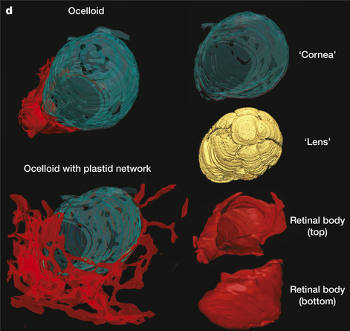Using AI to control energy for indoor agriculture
30 September 2024
Published online 15 July 2015
Scientists have found two specialized structures present within a single-cell marine plankton have evolved to form an “eye."

© Nature / Gavelis G.S.
Such complex structures are rarely found in single-cell organisms, but energy-producing mitochondria and pigment-containing plastids found in plant and algae cells were found to have combined in warnowiid dinoflagellates to form a complex “ocelloid,” or eye-like structure.
An international team of scientists, including an affiliate of Saudi Arabia’s King Abdullah University of Science and Technology, studied the genes of the dinoflagellate and of its individual structures and used electron microscopy and tomography on the cell. They found the ocelloid comprised a cornea-like layer of mitochondria and a retinal body of plastids. Plastids in dinoflagellates originate from an ancient symbiosis with red algae.
“This is a new level of integration seen between mitochondria and plastids,” says evolutionary zoologist Gregory Gavelis from the University of British Columbia in Canada. “Both these organelles are the ‘power plants’ of the cell. That they are assembling here to form an eye was pretty unexpected and shows that evolution can always find new uses for old parts,” he says.
The function of the eye remains unclear because scientists don’t have a complete understanding of the dinoflagellate’s life cycle. It is rarely encountered in the environment and extremely difficult to study. “The cells are very ‘shy’ in that they tend to stop swimming and eating once they’re caught. Often they just explode,” says Gavelis. Scientists have so far failed to cultivate them outside their natural environment.
Nevertheless, the team was able to observe one part of the cell’s life history using electron microscopy and found evidence to suggest that they feed on other dinoflagellates. The team believes that it is possible the eye is used to detect them.
The unexpected complexity of the single-cell dinoflagellates doesn’t stop here. “Amazingly, this species doesn’t just have an ‘eye’, but it has ‘guns’ as well,” says Gavelis. “Currently we’re trying to find out how these harpoon-like projectiles work and what the cell uses them for.”
doi:10.1038/nmiddleeast.2015.118
Gavelis, G.S. et al. Eye-like ocelloids are built from different endosymbiotically acquired components. Nature. http://dx.doi.org/10.1038/nature14593 (2015)
Stay connected: